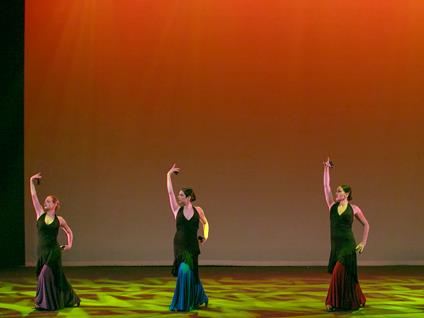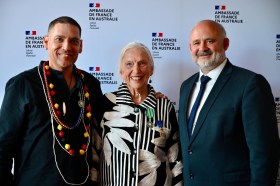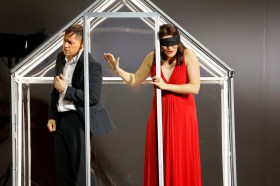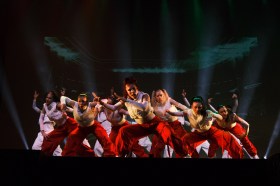Image by Energy Images.
Morning Melodies is His Majesty’s Theatre’s annual series of morning concerts. A total of five concerts are on offer: admission to each is only $25 so it attracts an audience largely made up of retirees. Local identity David Hawkes, formerly of the ABC, introduces each show in a jovial manner. This time he greeted us in French, and then he explained that even thought this was to be a Spanish show, there was no way he was going to speak Spanish. Why not? Two words. World Cup!
A few laughs later and Hawkes introduced the Danza Viva company, surely one of this country’s finest part-time companies working in any dance genre. Its members are well-schooled, highly disciplined and experienced. Sadly, they don’t perform often, so it was wonderful to see them dancing for a large and appreciative audience at the third of this year’s Morning Melodies at the Maj concerts.
All forms of Spanish dance were represented, from toe-tapping flamenco through to stylish classical, with folkloric items adding contrast and variety. The company has matured since I last saw them – also at a Morning Melodies concert – in 2012. The dancers have gained in artistic maturity as well as in years, although there was a delightful quartet of teenage dancers who provided the joie de vivre of youth: they lacked nothing in technique or professionalism, and their work was enhanced by sheer enthusiasm and unselfconscious enjoyment of the dance. They were balanced by three mature and polished soloists: Nicola de la Rosa, Sofia Predera and Intan Oldakowska, each of whom showed a deep understanding of the connection between technique and expression.
The opening ensemble, performed to the first movement of Rodrigo’s much-loved Concerto de Aranjuez, demonstrated an interesting exploration of the contrast between choreographic unison and canon. This gave way to a solo item to de Falla’s La vida breve danza no.1 from Intan Oldakowska. Accompanying herself on the castanets, the dancer gave us a range of emotions from the charmingly flirtatious to the deeply dramatic.
Several items were performed to no accompaniment other than the dancers own stamps and handclaps, and these were very impressive. The dancers moved as one, with never a beat out of place. Folkloric styles were represented by a cheerful jota, flawlessly performed by the younger dancers, and a beautiful fandango, performed solo by Sofia Pradera. The use of ribbons attached to her castanets lent this dance a festively jaunty air.
Particularly impressive was a dance for four couples. Four of the dancers wore trousers and waistcoats, but they also wore earrings and floral hair decorations and made no attempt to hide their feminine attributes. This was remarkably effective.
While it is disappointing that so few men take up Spanish Dance, it is never a good idea to try to pretend girls are boys, and the way these ladies danced, suggesting just a hint of butchness, was a nice compromise.
A very attractive Borboreo (Bullerias) choreographed and danced by Nicola de la Rosa, suggested a Middle-Eastern influence. The dancer used a shawl as a prop in very much the same way as a Middle-Eastern dancer uses a veil. Some of the body movements also suggested an influence from the other side of the Mediterranean.
In the Tientos Tangos, an ensemble number, we got tragic undertones balanced by moments of pure sensuality. The dramatic effect was stunning, to say the least.
The company can boast that its baker’s dozen of dancers are all trained in classical ballet as well as in the Spanish styles, and this can be seen in their grace and stamina as well as in their technical accomplishments. For the final item we returned to the Concerto de Aranjuez, this time the third movement, during which several dancers performed a lengthy series of renversés en dedans, followed immediately by a balance en attitude on half toe. Many dancers would wobble, if not actually stagger, after such a feat – and this after dancing almost non-stop for an hour! – but it was all in a day’s work for the ladies of Danza Viva.
Karen Henderson is to be commended for her utterly lovely costumes. She has gone for an understated, classic look, which can sometimes appear boring. But in this case, what came across was elegance and sheer class, with just the right accessories giving a finished style that always complemented the choreography.
The recorded music, while not ideal, was well-recorded and presented. While live music would have lifted the performance, it is understandable that budgets, in show business as well as politics, can be a stumbling block.
Deanna Blacher can be very proud of her achievements in Western Australia. She has put Spanish dance well and truly on the local map. Some twenty-odd years after founding her school and company, she now has several teachers in the state carrying on her work. Spanish dance is here to stay. Viva la danza!
Rating: 4 ½ stars out of 5
Morning Melodies presents: Danza Viva
Director: Deanna Blacher
Costumes: Karen Henderson
Sound recording: Hannah Felton
His Majesty’s Theatre, Perth
www.danzaviva.com
25 June






